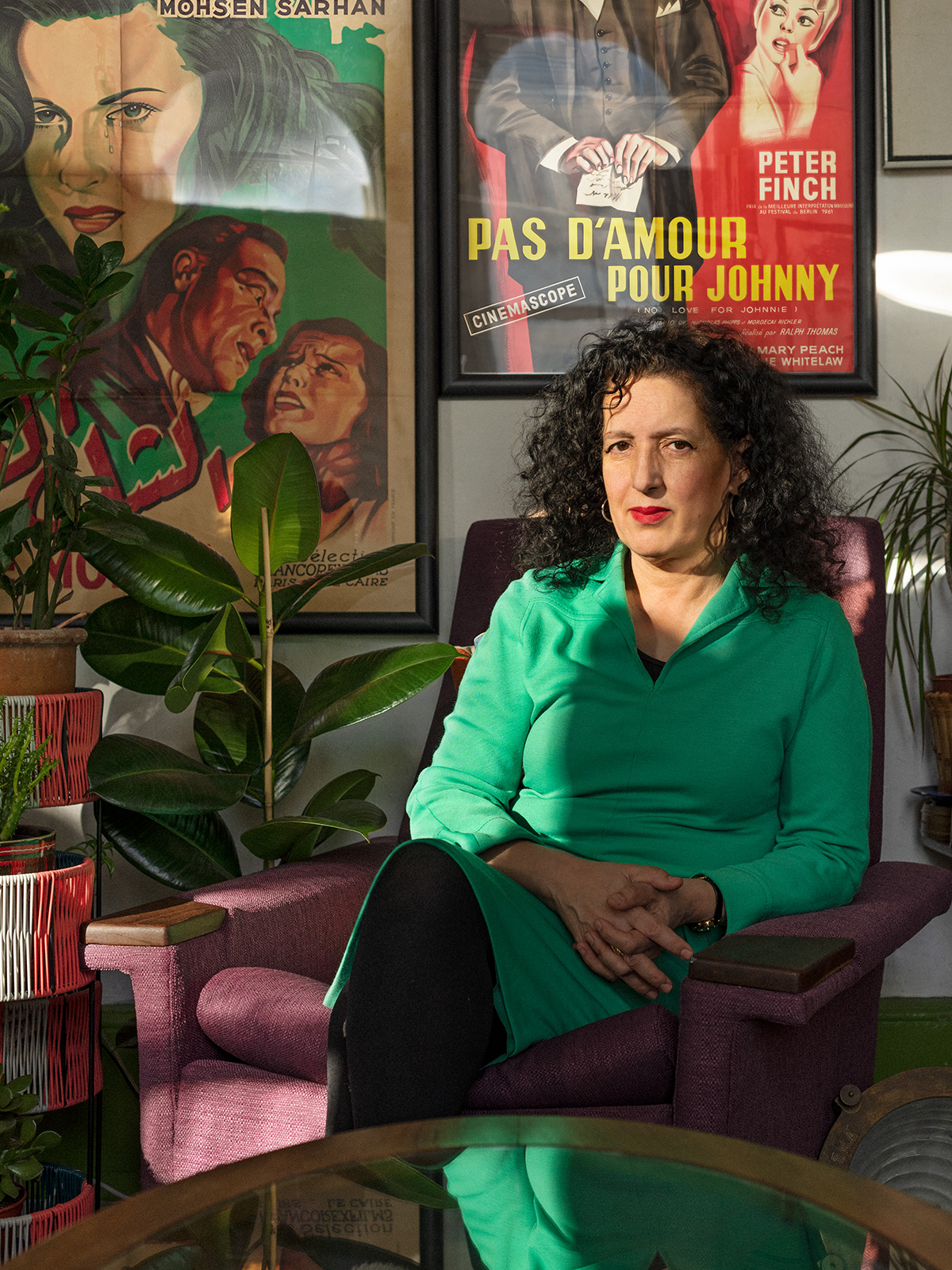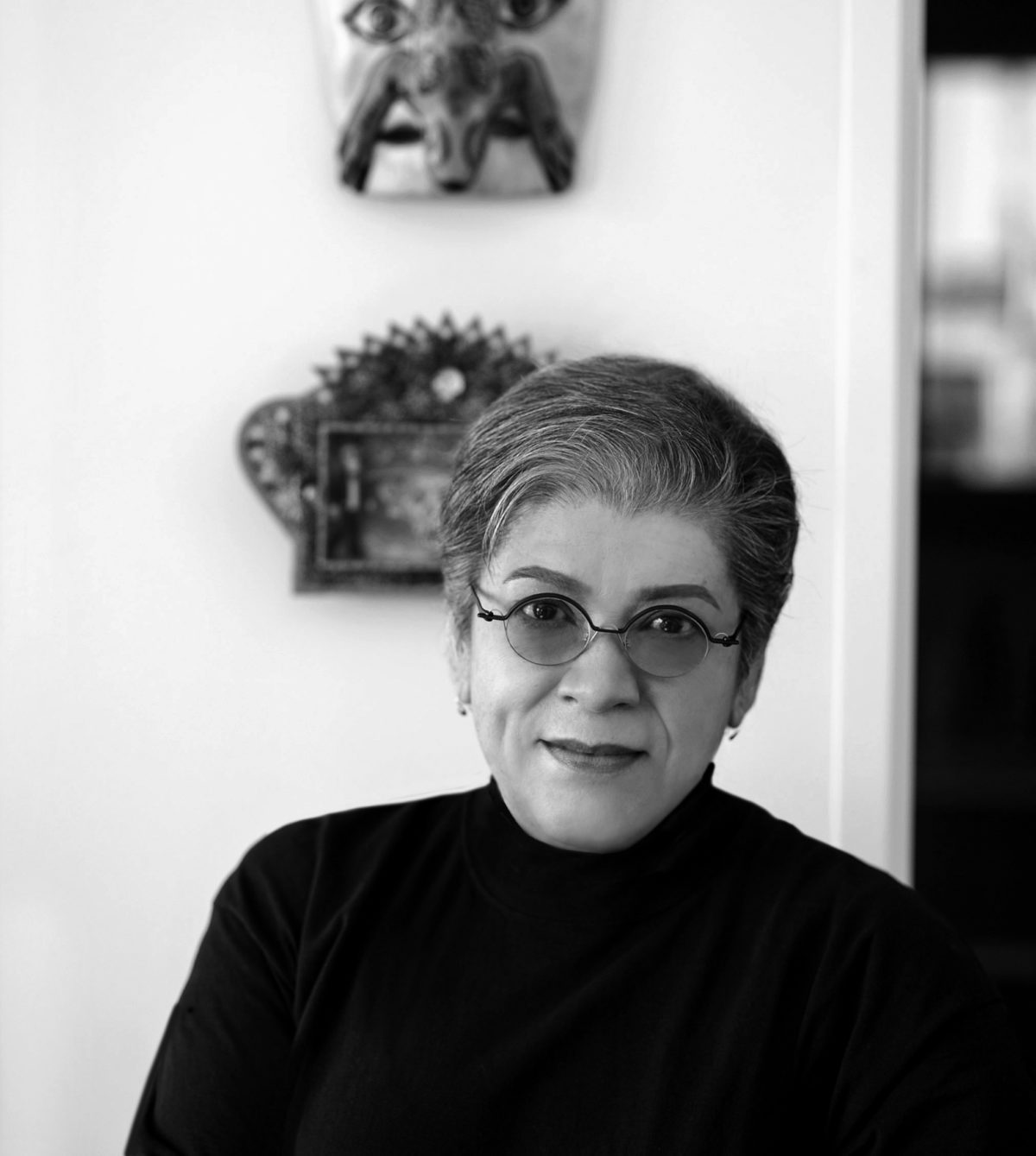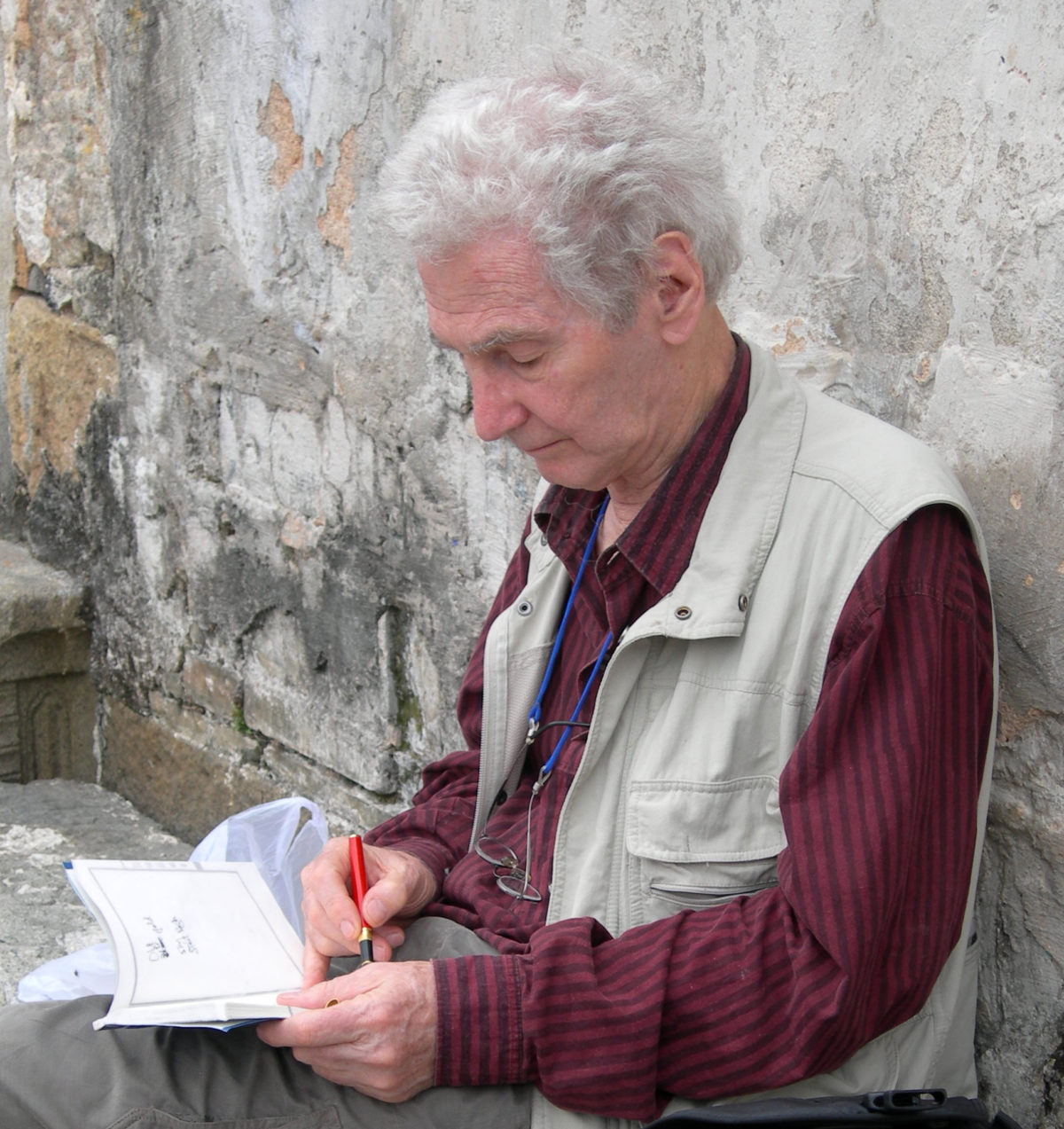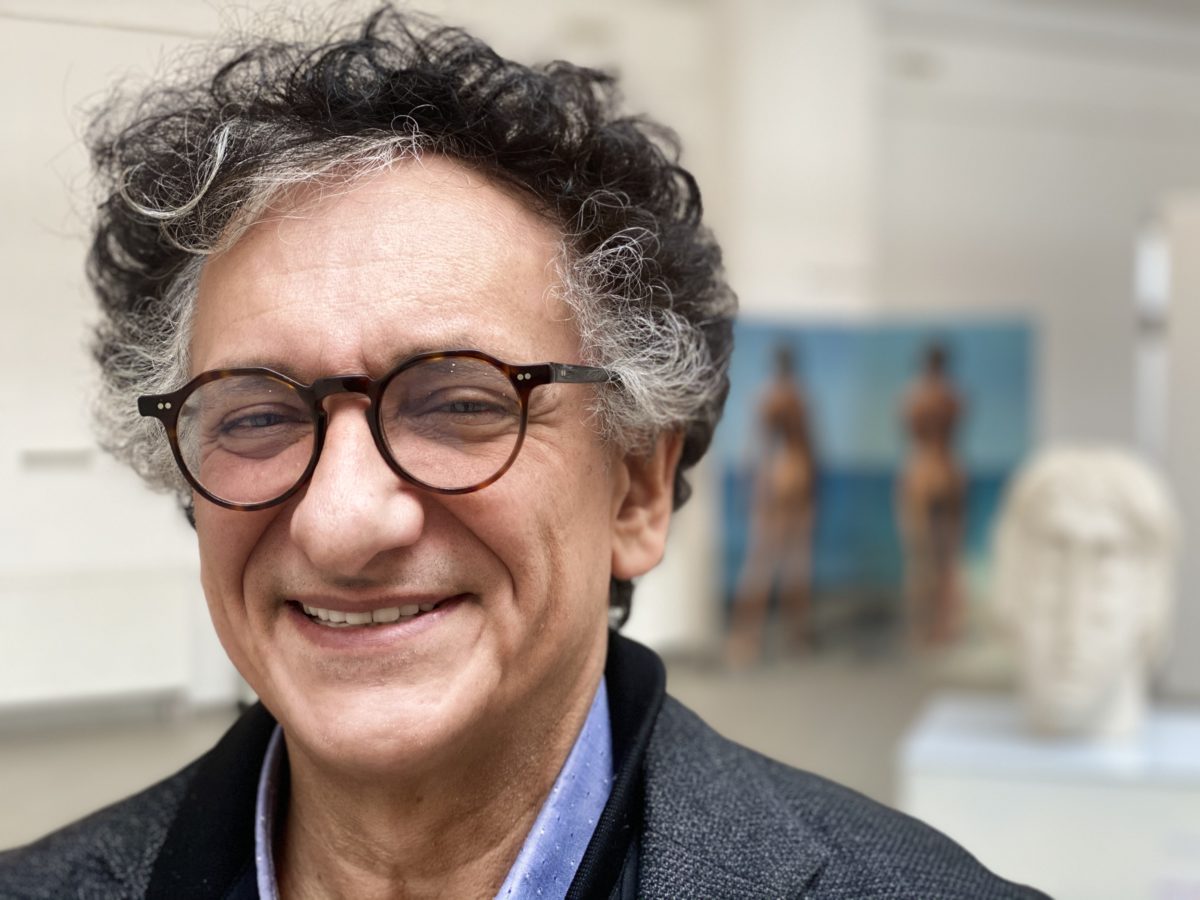
Unable to meet in person due to the pandemic travel bans, Zineb, in her South London Brixton studio, and I, in the wildfire-ridden Bay Area, engaged in a Covid-era virtual interview. We covered a range of topics including how Sedira defines imperialism, her upcoming work representing France at the Venice Biennale 2022, and her use of archival materials.
Zineb Sedira has been mining her personal relationship to post-colonialism and a transnational identity in her artistic practice for over 20 years. Sedira’s work in photography, video and installation continues to draw on the silenced cultural history of Algeria and her own autobiography to create work with expansive themes around memory, migration and the archive. Posing important questions on the relation between history and aesthetics, trauma and form, Sedira has established herself as a significant voice in the global contemporary artworld conversation.
Born in Paris in 1963 to Algerian immigrant parents and raised in the banlieues of Paris, Zineb Sedira graduated from London’s Central Saint Martins and the Slade School of Art, where she was influenced by Stuart Hall’s British Cultural Studies and the Black Arts Movement. Her work has been shown in several solo exhibitions, most recently at the Jeu de Paume (Paris, 2019), the IVAM‑Institut Valencià d’Art Modern (Spain, 2019), the Beirut Art Center (Lebanon, 2018), and the Sharjah Art Foundation Art Spaces (UAE, 2018).
Sedira is the founder of aria, an artist residency program in Algiers that supports the development of the contemporary art scene in Algeria through international cross-cultural exchanges and collaborations. Zineb Sedira will be the first artist of African descent to represent France at the 2022 Venice Biennale.
NB: What does “After Empire” mean to you? How do such questions play out in your recent work on the Pan-African Festival in Algeria in 1969, Standing Here Wondering Which Way to Go, an installation first shown at the Jeu de Paume in Paris in 2019 and commissioned by Jeu de Paume, Paris, France; IVAM, Valencia, Spain; Gulbenkian, Lisbon, Portugal; Bildmuseet, Umeå, Sweden.
ZS: In the 1960s many African, Latin American, and Asian countries were becoming independent through diplomatic negotiations or wars. These countries had arrived at what I would call the “End of an Empire” era. At the height of these struggles, leaders of these countries joined forces under the Non-Aligned Movement (NAM) created in 1961 in Belgrade. It was created to counteract capitalism and Western imperial powers. The movement fiercely opposed apartheid governments, supported diverse guerrilla movements, and stood up to imperialist wars around the globe.
In 1969, the Pan African Festival of Algiers—mandated by the Organisation of African Unity (OAU)—was organised (and largely financed) by the Algerian State. It was a celebration of the victory of the Algerian War of Independence, the armed struggle waged against French colonialism (1954 to 1962). The festival was an enactment of anti-imperial positions and showed the desire for Algeria to engage on a global scale economically and politically.
It is clear, however, that 60 years later these “after-imperialist” ideas failed, to a certain extent, as some African countries have had to rely on these major power blocs again, being re-colonized and economically dependent all over again. They have had to create economic dependency in order to survive thus entering into a new form of subordination and enslavement. So, I think my installation Standing Here Wondering Which Way to Go is pertinent as it reminds us of the 1960s political anti-imperialist consciousness and the complexity of inter-related cultural and global political trends. It also highlights the failures and fallibility of the politics of that time. The installation also extends to the different social movements that were developing in the ‘60s, the golden age of protest movements. This was a decade of dynamic social activism denouncing wars, bigotry, police brutality, poverty and hunger, women’s oppression and other inequalities…
After 1970, the memories of optimism and global solidarity faded away, leaving a sense of mourning for the passing of a once imagined bright future. As a result, the global demand for greater social justice and a redistribution of wealth still exists and is even more urgent today with world population growth and climate change.

How do you distinguish between anti-colonialism and anti-imperialism in your work?
I agree with Edward Said’s statement: “Imperialism involves the practice, the theory and the attitudes of a dominant metropolitan center ruling a distant territory, while colonialism refers to the implanting of settlements on a distant territory.” So, I understand colonialism as the physical control of another country and imperialism as referring to the politics and economics of domination, and is often connected to the British Empire. As an artist of French Algerian background living in the United Kingdom, much of my work explores and exposes French colonialism and British imperialism together through both my own family’s history and my everyday life in London.
Do you feel that we are in a new countercultural moment globally with #MeToo #BlackLivesMatter and other contemporary socio-political movements?
I do believe there is a kind of countercultural “moment” with #MeToo and #BlackLivesMatter. I am happy to see that people all across the world have taken a stand against police violence and racism. During the Covid-19 crisis, we also witnessed race and class inequalities as evidenced by the scale of the loss of life and the economic consequences, especially catastrophic for the working class. Since the killing of George Floyd in the US happened during the pandemic when almost everyone was at home, faced with the same fears and focussed on the media and screens, it generated favorable conditions for a political consciousness and a moment of global solidarity. Other political movements, such as Extinction Rebellion—a global environmental movement abbreviated as XR—have also created strong universal alliances. But the big question remains, will this countercultural moment be sustainable?
In your 2002 video Mother Tongue you explore three generations of your family——your mother, you and your daughter——each speaking in her own “mother tongue”——Arabic, French and English, respectively——to the others but unable to communicate directly. This video reveals a bond that goes beyond language and nationality and generations and is specific to diasporic identity. The fact that Mother Tongue has been shown around the world and continues to resonate deeply with audiences makes me think that this work points to a utopian desire in all of us.
Wouldn’t it be great if everyone could understand each other through languages and shared knowledge of each other’s cultures, traditions and art… without having to negate or erase them or each other? Perhaps this is where racism, intolerance and discrimination could be overcome? I know it sounds naive but it is definitively my utopian view and my hope. And perhaps this romantic future rests with the diasporic communities?
I must say I was surprised by this selection, but I feel honored to represent France at the Venice Biennale 2022. It is a major shift for French contemporary art and France’s relationship to its complex history with Algeria. As an Arab-Berber-Algerian-French-woman based in London representing France, I interpret the choice by the French government as a political statement.
I share your utopian views. Speaking of hopes and wishes: you have been selected as the first artist of African descent to represent France at the 59th Venice Biennale in 2022. Your selection marks the fourth time that a woman would represent the nation, following Annette Messager (2005), Sophie Calle (2007), and Laure Prouvost (2019). Without revealing too much about your Pavilion’s theme and content, could you tell Dispatches about your initial response to being selected to represent France, the country of your family’s very personal colonial experience?
I must say I was surprised by this selection, but I feel honored to represent France at the Venice Biennale 2022. It is a major shift for French contemporary art and France’s relationship to its complex history with Algeria. As an Arab-Berber-Algerian-French-woman based in London representing France, I interpret the choice by the French government as a political statement. It is a strong signal to change the international “image” of the French contemporary art scene as well as a form of “reconciliation” with the country’s now multi-generational immigrant community. It is, finally, an acknowledgment of France’s true diversity.
But what I was not prepared for was the level of discrimination and intimidation that occurred in response to my nomination. I was subject to defamatory accusations by a group of people that was hoping that the Ministries of Culture and Foreign Affairs would withdraw the nomination or that I might renounce representing France. Of course, this did not happen. As an Algerian-French woman and an artist, I have been given an opportunity, a platform, a voice to continue being critical of all forms of hatred and racism. So, despite this attempt to silence me and infringe on my freedom of expression, I will be representing France at the next Venice Biennale!
Often this type of attempt to silence or negate—and this is not the first time my work has been censored—motivates one even more to fight back. As disturbing as it can be to experience such bigotry, it provokes me to continue to produce art and tells me somehow that the work I am doing is important and still valuable. So, when I started thinking of an art project for the French Pavilion in Venice, I was undeniably going to continue with the work recently explored: cultural and political solidarities within a post-colonial context most likely using archival materials such as film.

Bravo! So, the fight continues. With it do you feel the “burden of representation,” as Kobena Mercer once called it, now more than ever? How are you engaging with such a personal and political moment in French contemporary art and a country that has really not yet engaged in representing its recent past in Algeria?
I do understand what Kobena Mercer calls the “burden of representation.” However, as my work is as personal as it is political, I do not feel I am or have to be an “authority” on the subjects that I explore. Identity is intersectional—politics, race, gender and class all play a part. There isn’t one way to represent one’s “diasporic” experience. It is obvious that the work I will make for the Venice Biennale will be connected with my favorite themes.
Identity is intersectional—politics, race, gender and class all play a part. There isn’t one way to represent one’s “diasporic” experience
You are committed to resisting French amnesia and aphasia intrinsic to its colonialist past. So much of your work is about revealing the silent unspoken history of this violent past. Please give us an example of work that does this.
Many of my works address French—and to a certain extent Algerian—historical amnesia and aphasia. In 2003 I created two video installations, Mother Father and I (2003) and Retelling Histories: my mother told me… (2003), where my parents recall their experience of the Algerian revolution fought against French colonialism. These two pieces tell the stories of my parents’ life in a rural area confronted by French army atrocities. It was the first time that my parents had spoken so extensively and openly about their colonial experiences as young adults.
I am interested in listening to and transmitting stories by ordinary people and not the voices of political leaders or the ruling elite. For example, Image Keepers (2010) is a video installation that addresses issues of memory and history. The work values individual memory as another way to access history via personal legacy and experiences as well as archives as sources to understand the world.
The work relates to the photographic collection of Mohamed Kouaci (1922-1996), photographer of the Algerian revolution and independent Algeria, now managed by his widow, Safia. These portraits and photographs are precious and invaluable documents that bear witness to the history of the Algerian war and post-independence by an Algerian citizen, rather than the “official” journalism and French army documentation. Here, the memory invoked is personal: we discover the photographer through family memories, anecdotes that speak of the man or husband as much as of the professional or the activist. The emphasis is on living memory, carried and transmitted by a witness who understands the link between past and present. The video installation becomes a space of commemoration, of re-memory.
So here, I am using oral history and a photographic archive to question amnesia and aphasia that often occur after a colonial period. I also ask myself: What role can the archive play in developing and sustaining a critical and culturally located art history that speaks not only to the past but to the present and the future? How does art negotiate the potential and the pitfalls of the archive as source material?

Yes, your use of archives seems to be more and more a central part of your practice. How do you, as you say, “negotiate the potential and the pitfalls of the archive as source material”? How do you use the archive for story-telling?
I think about the problems of the archives as primary source material in many ways. I think we search for fragments of the past to understand the present. When we examine the present, we must understand our own past: the past that has informed our own personal present. That’s a philosophy of life that I live by and that is hopefully expressed in the work that I do.
I have been interrogating histories and archives—primarily those that have been hidden, destroyed, altered, or neglected—to create counter narratives from the official ones, whether French or Algerian. As an artist, when using conventional archives, I am often struggling not to fall into what I call the “fetishization or reverence” of the archive. I often use the aesthetics of decay and death to reflect on loss (as in the video mise-en-scène, 2019, or again in Haunted House, 2006, to name but two) and on the need to expand the past because we cannot expand the present.
I have done research for many projects using conventional archival materials found in repositories such as museums, state and private archives as well as libraries. From this research, I then compile my own archive or collection, so to speak, of images, objects, music, film, photography, furniture, fine art (painting and sculpture) as well as literature and ephemera. I generate a new form or system of knowledge and information which I hope disrupts and replaces the conventional archive. I am proposing a generous and generative alternative access to historic documents and data that remain outside the mainstream libraries and museums.
In the processes of photographing and “recording records” with my iPhone, the archive presents me with its own indelible vulnerability to reinterpretation, if not its own shortcomings as a document. The documents selected interrogate the impermanence of image archives and underscore the difficulty of preserving the analog in advance of digital solutions. This question of the relationship of the archive with technology today interests me greatly. How do we store and label archival data? Do we still restore and conserve the original documents? What do we lose in this digital transformation?
By using discarded, damaged and neglected archival material I try to protect and transmit the fragments of a collective memory built on lacunae, traumas, secrets and the unspoken. These lacunae were inked in the past, but yet echo between one generation and another, from the past to the present and back to the past again.
Indeed. I was really struck by the beauty of the nine-minute film entitled, mise-en-scène 2019, which you made as part of your exhibition A Brief Moment at the Jeu de Paume last year. It opens with a text reading, “In June 2018, after a visit to the Cinémathèque of Algiers archive, I decided to browse in bric-à-brac shops… I discovered two canisters containing fragments of worn ‘60s, ‘70s and ‘80s films. The vendor told me the canisters came from a retired projectionist… so I pieced the footage together to create my own film.” This spliced together and colorfully tinted patchwork of images that range from abstract patterns to mundane scenes of Algerian life felt like a living archive. It got me thinking about the status of a national Algerian cinema archive or cinémathèque. This is a strong example of the political effect of your repurposing found archives—the questions that are engendered.
In fact, there are official film archives in Algeria. They can be found at the Cinémathèque of Algiers, the RTA (Radio and Television Broadcasting) or the CNCA (National Center for Cinematography and Audiovisual) to name a few. However, as much as the RTA and CNCA seem to have looked after their archives, the Cinémathèque of Algiers has been struggling due to the considerable volume of documents/archives followed by the advent of political turmoil such as the Berber Spring cultural uprising (1980), and the civil war referred to as the Black Decade (1990), when official interest in the film industry decreased significantly. The abandonment of cinema and its proper archiving impacted all of Algerian culture. And, since Algiers is situated by the sea, natural elements have severely eroded these precious films, photographs and other documents. Thankfully, over this last decade, the cultural ministry has prioritised restoration, especially of the 35mm and 16mm Algerian film stocks.
Having said this, the issue is still the lack of access to these materials for researchers, academics or artists like me. Also, the films that have been restored so far are not distributed by DVD or live stream, so they continue to remain inaccessible to the Algerian people who are denied the knowledge of their own film history.
When I found the canister with these damaged and discarded bits of film, I was very curious about the images I would find and I knew they would be very precious to me. In mise-en-scène 2019, I created a kind of collage of these fragments, a new form of re-appropriation of the archive creating a visual history. The audience is invited to imagine stories behind the frames, undertaking their own archaeological work that studies the fissures, scratches and erosion of the archives. I believe old photos or films offer glimpses into a past through printing errors, stamps, scratches or stains, hand written notes or marks, etc. These traces have directly affected the life of the documents and are important to me as they provide new stories.
By using discarded, damaged and neglected archival material I try to protect and transmit the fragments of a collective memory built on lacunae, traumas, secrets and the unspoken. These lacunae were inked in the past, but yet echo between one generation and another, from the past to the present and back to the past again.

What is your relationship to Africa today? How do you see your work as challenging our notions of Africa and the African diaspora?
As I was growing up in France in the 1960s and ‘70s, the Maghrebi communities (Moroccan, Tunisian and Algerian) were not considered “African” by the French. Perhaps this was to divide and conquer (or divide and rule) us further? However, in Algeria there was another narrative: we were African. So, my relationship to Africa is linked to my Algerian identity and the 1960s-70s Pan Africanism ethos that developed in the country.
As a political or cultural movement, the idea was that peoples of African descent have common interests and should be unified by their colonial histories. Justifiably, the story of anti-colonialism had created many alliances between Algeria and the rest of Africa (as well as other continents). I really feel connected to African culture and politics and follow what is happening there avidly. I am very interested in other forms of imperialism on the continent such as China’s Soft Power in Africa. Due to the many conflicts, institutional corruption and poverty in Africa, China is gaining strong economic power on the ground. Perhaps this is another art project to explore!
As long as there are any forms of imperialism, racism and injustice globally, I believe it is our responsibility as artists to expose and question them.




